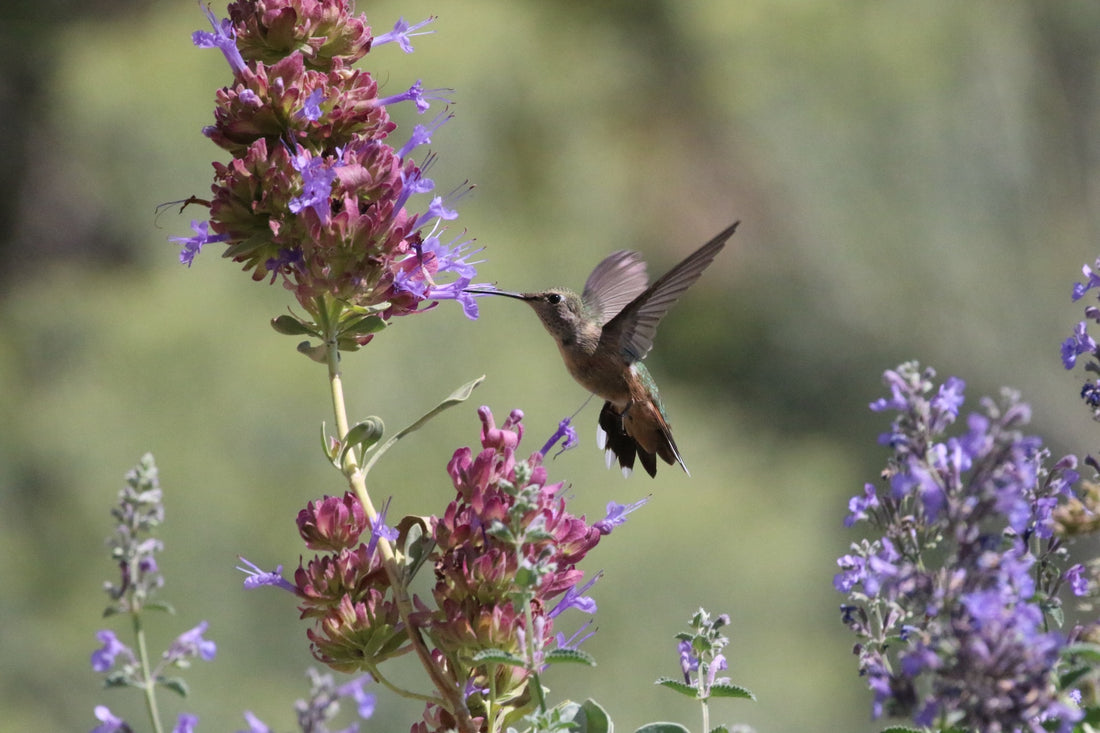Hummingbirds are important pollinators in the garden, and the ecosystem as a whole. Plus, they're beautiful! More than 160 native North American plants depend exclusively on hummingbirds for pollination. If you want to see more of these wonderful and beneficial birds in your garden, it takes a little bit of effort. But not too much! Hummingbirds have a strong memory and will return to places where they have been previously fed.
Hummingbird Life 101
The male hummingbird arrives before the female and, despite its small size of only 3 to 4 inches and less than 2 ounces, it needs a large amount of nectar from flowers or feeders to maintain its body temperature and fast metabolism. These birds thrive in a habitat similar to a woodland, with access to nectar, flowers, spiders, and small insects, as well as a reliable water source. They find shelter and resting spots in trees and woody plants at night.
The female returns to the same location every year to build her nest in the small branches of trees or woody shrubs, using materials like plant fibers and lichen. She takes care of the eggs and typically has two broods, with each egg being approximately the size of a small bean.
During September or early October, many hummingbird species commence their journey to Mexico (or further). The timing of this migration is not within our control as it is influenced by a photoperiod, which is characterized by shorter days and longer nights.
To prepare for their extensive flight to the south, the hummingbirds must increase their body fat by 50%. As most flowers have already stopped blooming during this time, they will depend on the nectar from your feeders to sustain them until they depart. By providing a suitable habitat and adequate nectar, you can enjoy the presence of these vibrant birds in your backyard for many years.
Not only do hummingbirds add beauty to a garden, but they also play a crucial role in pollinating many native plants in the northeastern United States.
How To Attract Hummingbirds To The Garden
Bird Feeders
To attract hummingbirds, it's best to place feeders outside just before the blooming of flowers, shrubs, and trees, typically around the beginning of April. This is approximately when they'll start showing up after their long migrations; and they'll be hungry!
Proper maintenance of feeding facilities is essential in attracting hummingbirds year after year. Unlike traditional bird feeders, hummingbird feeders are filled with nectar instead of birdseed. These can be purchased at various retail stores, bird and gardening catalogs, or online. It is recommended to choose a feeder with minimal components that are easy to clean. It is also beneficial to have a red exterior, as this is the hummingbird's preferred color.
Feeders are available in different styles, sizes, and prices, but the birds are only interested in the nectar, not the feeder's appearance. To avoid territorial conflicts, additional feeders should be placed in areas that cannot be seen from existing feeding spots. It is best to hang them in partially shaded areas with minimal foot traffic, allowing you and your family to observe and appreciate the hummingbirds' acrobatic displays as they quickly move in all directions.
A nectar-like product can be bought at a store or made at home by combining 4 parts water with 1 part granulated sugar. Boil the water, add the sugar, and mix until it dissolves. If your feeder has red parts, there is no need to add coloring to the sugar water.
It is best to only partially fill your feeder in the spring before the hummingbirds arrive; any unused nectar can be stored in the fridge for up to 2 weeks. Keep the feeder filled at all times as hummingbirds have large appetites and will seek food elsewhere if the feeder is empty. During the hot summer months, the sugar-water mixture can spoil quickly and this will deter hummingbirds from drinking it.
It is recommended to clean the feeder every 5 to 7 days, and more frequently during mid-summer when temperatures are high and there is a higher risk of mold. Cleaning the feeder is simple. Wash it with hot water and add some vinegar (which helps prevent mold), paying extra attention to the small feeder openings. A bottlebrush or pipe cleaners can be used to clean these tiny areas. Rinse thoroughly and refill.
Be cautious of ants and bees who have a strong affinity for the sugar solution. Ants will go to great lengths in order to consume it. An effective solution to this issue is to grease the cord or chain above the feeder when it is hanging from a tree branch, using a petroleum-based product. If the feeder is on a shepherd's hook, coating it with vegetable oil or a petroleum product can also work. Remember to reapply after it rains. You may also encounter bees hovering around the feeder openings, attempting to access the nectar. To prevent this, try placing a small dish of sugar water away from the feeder to discourage the bees. It is crucial to avoid harming these helpful insects.
Wild Flowers
Hummingbirds are attracted to flower colors rather than their scent, as their sense of smell is not well-developed. While they will consume nectar from a variety of flowers, they particularly favor those that are red, orange, or pink, such as petunias and butterfly weed.
To ensure a constant food source and encourage their return, it is beneficial to have long-blooming plants like Bergamot and bee balm. Due to their long beaks and tongues, they can easily feed from tubular flowers like trumpet vine. If outdoor space is limited, hanging baskets or window boxes with flowers and plants can also attract these birds to your garden.



